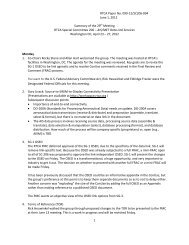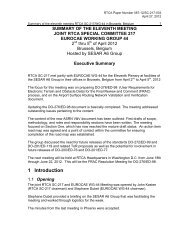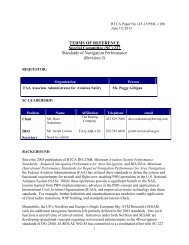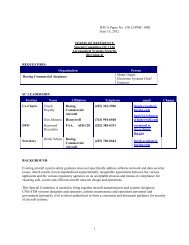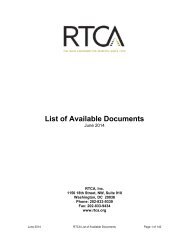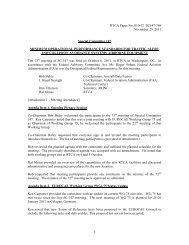SC-226 MEETING MINUTES Working Group JANUARY 14 ... - RTCA
SC-226 MEETING MINUTES Working Group JANUARY 14 ... - RTCA
SC-226 MEETING MINUTES Working Group JANUARY 14 ... - RTCA
Create successful ePaper yourself
Turn your PDF publications into a flip-book with our unique Google optimized e-Paper software.
<strong>RTCA</strong> Paper No. 021-13/<strong>SC</strong><strong>226</strong>-010<br />
February 6, 2013<br />
Industry:<br />
Some aircraft manufacturers require headsets with impedance that shall be between the<br />
limits of 8 Ω and 32 Ω± 20%.<br />
An equivalent level of safety is provided limiting the use of headsets with low impedance<br />
in the aircraft or helicopters that require low impedance.<br />
<strong>SC</strong><strong>226</strong> committee response:<br />
The committee has addressed the use of 8 ohm and 50 ohm (representative of multiple 150 ohm)<br />
headsets connected in parallel. 8 ohm is now considered within the revised standard as “low<br />
impedance”, 600 ohm is now considered “high impedance” and 150 ohm is considered “commercial<br />
aviation impedance” headsets.<br />
The committee knows of no application of 32 ohm headsets being used in cockpit communication<br />
applications. 32 ohm headsets that the committee is aware of are typically consumer style headsets<br />
such as those used in the airline passenger cabin for music listening purposes, or those sold on the<br />
consumer market for IPOD music players. As such, 32 ohm headsets are not deemed appropriate for<br />
coverage by the revised standards.<br />
On the subject of damage to equipment occurring due to the use of low impedance headsets on a<br />
system intended for high impedance headsets, the committee considers that the standard also has a<br />
requirement for a short circuit test that is intended to insure the equipment is protected against<br />
damage due to low impedances being inadvertently connected. However, the committee also considers<br />
that there could be legacy equipment still in use within aircraft that may not have been required to<br />
meet the short circuit test contained in previous standard DO-170 or current standard DO-2<strong>14</strong> and as<br />
such, the note below DO-2<strong>14</strong> section 2.3.5.2 still applies. Note as follows:<br />
Some general aviation avionics equipment may require the use of headsets with 600 Ω impedance only. Use of lower<br />
impedance headsets could result in damage to such equipment. Therefore, headsets which have an earphone circuit impedance<br />
other than 600 Ω ±20% shall include in their installation instructions a caution stating the following: "Damage could occur<br />
to avionics equipment by the use of these headsets if the equipment was manufactured for use with 600 Ω headsets only-if in<br />
doubt, consult the avionics equipment manufacturer."<br />
EASA deviation ETSO.DevP.27.pdf Deviations requests ETSO.Dev.P027 for an ETSO approval for CS-<br />
ETSO applicable to Headset including Microphone (ETSO-C57a, C58a) Consultation Paper<br />
<strong>SC</strong><strong>226</strong> committee response:<br />
To address headset cord connector pull out the following note has been added to the standard section<br />
2.2.8.3 and 2.3.8.4:<br />
Note: The earpiece-cord fastening for the headset will be subject to less amount of steady pull<br />
as the headset is not fixed at the head and the headset is not connected to a fixed mounted panel.<br />
Page 9 of 20




